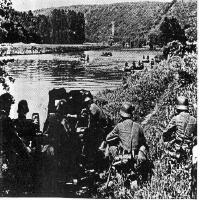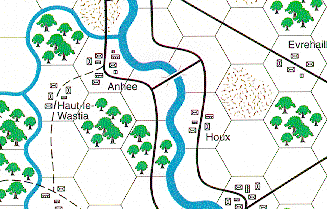|
|
|
|
Rommel at the Meuse The German offensive against France was decided by the swift advance of the Panzer columns through the Ardennes forest and a quick crossing of the Meuse River. One of the leading divisions was the 7th Panzer lead by a young Erwin Rommel. One 11 by 16 inch color map, 186 color counters, rules, organizational charts, and tables. Units are battalions and companies, each map hex represents 1.5 kilometers, and turns represent 4 hours. Simple combat system, with rules covering river crossings, combined arms, refugees, and Rommel. The French have several tough formations, including their best armored division, so that history does not have to be repeated. 2nd edition map and counters $14.00
|
|

|

|

|
|
|
Historical notes (from the rulesbook) Abbreviations used
18 DI = 18 Division d'Infanterie 1 DLC = 1re Division Legere de Cavalerie 4 DLC = 4e Division Legere de Cavalerie 5 DIM = 5e Division d'Infanterie Motorisee 4 DINA = 4e Division d'Infanterie Nord-Africaine 1 DCR = 1re Division Cuirassee GRDI = Groupe de reconnaissance de division d'Infanterie; the armored cars and recon elements for the infantry division. BDAC = Batterie divisionaire anti-char; the 47mm anti-tank weapons of the division. EDAC = Escadron divisionaire anti-char; the 25mm anti-tank weapons of the DLC's. The campaign The German offensive against France opened on May 10, 1940. German armored spearheads penetrated the rugged Ardennes forest, sweeping aside the Belgian cavalry screens (the Chasseurs Ardennais). The XVth Panzer Corps under Hoth was spearheaded by the 7th Panzer Division, only recently converted from a Light Division. The 7th Panzer Division, led by a young General Erwin Rommel, rolled over French DLC forces as well, giving them a mauling at the Ourthe River crossings. The DLC's retreated to the west bank of the Meuse, just as the French armies advanced from their positions in northern France to the Belgian defensive lines along the river. The DLC and Chasseur screening forces were supposed to give the Allies four days to take up their positions. Instead, the German recon elements were at the Meuse on the afternoon of May 12, with the armor close behind. French units in the Dinant sector found Belgian pillboxes locked and empty. In the hasty advance, most of the anti-tank ammunition had been left behind in France. The engineers detonated the explosive charges on the Meuse bridges, in one case just as German armored cars were on the bridge itself. As the French forces hurried to take up positions, the Germans probed for crossing sites. The direct approach, such as at Dinant, proved costly for the Germans. Pontoon assault boats were shot up by well-placed French defenders of the 18th Infantry Division. The German attack had stalled, and it looked like the Allied plan might be working after all. The Allied planners had made no provisions to confiscate civilian boats, nor to destroy the various locks and flood control devices (weirs) that existed along the river. The feeling was that to destroy the weirs would lower the water level of the Meuse to such a point that the Germans could have forded the river at the shallower points (it had been a very dry winter and spring). Several of the French companies did not follow their orders to the letter, and did not deploy at the river's edge. Many of their assigned areas of responsibility were actually open fields, while the Germans on the east bank were in cover and on higher ground. They kept up a good rate of fire, and prevented the Germans from crossing the weirs at several locations. Then came nightfall (May 12/13th). Under cover of darkness a German motorcycle unit (the 7thMC of the 7th Pz) was able to cross the weir at Houx (hex 2004) on the footbridge and gain a foothold on the west bank of the river. The French battalion commander called in artillery, but even the 1200 rounds fired were totally ineffective. The weir remained intact, and the Germans were across. French resistance along the river on May 13th was weakened by the lack of depth and reserves. The local battalion and regimental commanders tried to carry out local counterattacks, but lacked the resources (fresh troops and armor) to do the job properly. Under Rommel's direction the engineers constructed pontoon ferries capable of taking tanks across the river. Armor companies were deployed along the east bank, and acted as mobile artillery supporting the crossing infantry. The small bridgehead from Houx to Leffe (hexes 2004 to 2106) was expanded (Leffe is a small suburb of Dinant). Anti-tank and other heavy weapons were also carried across, as Rommel anticipated an armored counterstroke. This was not to be, as the French 1DCR was immobile 25 miles behind the lines, and had not been released by the Army command. By dawn of the 14th the Germans had expanded their bridgehead towards Haut-le-Wastia (hex 1704) and Onhaye (hex 1708). German forces poured across the river. Hoth was impressed with Rommel's success, and gave him temporary command of the panzer forces from the 5th Panzer Division to exploit the situation. The French command was by this time in a real panic, and tried to commit their reserves. Both the 4th North African Division and the 1 DCR were on their way to the area. The 4th NA fought a series of tough battles between Anthee (hex 1208) and Onhaye (hex 1708), but were committed piecemeal and destroyed. The village of Anthee changed hands several times, and the Germans were quite surprised by the ferocity of the Algerians. Several units of the 4th NA fought to the last man as Anthee burned down around them, and certainly challenged the German notion of untermenschen. The 1DCR was truly in the wrong place at the wrong time. Orders failed to pass from Army to Corps to Division in a timely manner, and the 1DCR was already a day late in moving. Refugees hampered the road columns, and the lead elements only reached the Florennes area (roughly hex 0807) by nightfall of the 14/15th. The armor was out of gas, and the petrol trucks were at the rear of the columns. The petrol was ordered forward, and refueling began around 0900 on the 15th. No sooner had this begun, than armored columns of the 7th Pz raced past Rosee (hex 1008) and towards Philippeville (hexes 0210-0310). They were followed by even larger columns of armor and motorized troops from the 5th Pz, which was covering the right flank of the 7th Pz. These columns fell upon the 1DCR, and only about 10 French tanks survived the very one-sided fight. As the French 9th Army disintegrated, Rommel pushed through Philippeville and headed west. The speed and intensity of the German attack, coupled with the piecemeal commitment of forces and lack of depth, had doomed France. Historical notes, counter art, and map art are ©1995 Randy Moorehead |
|
|
|
|